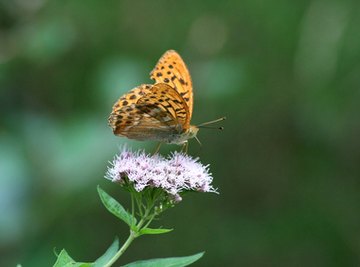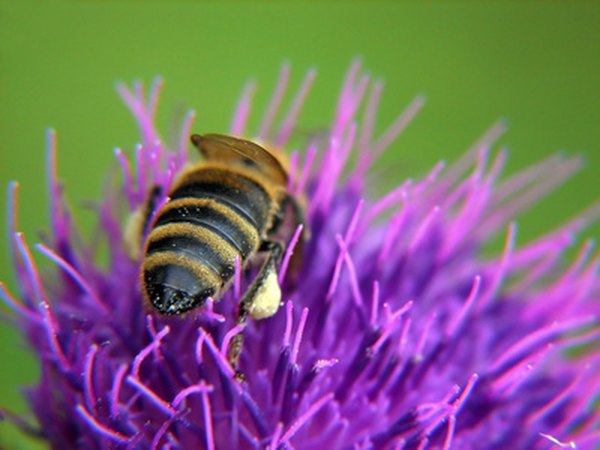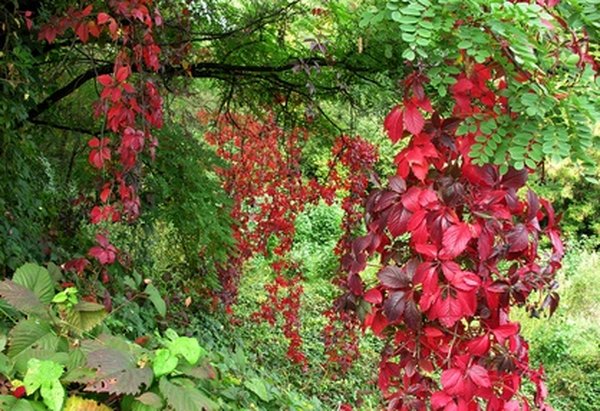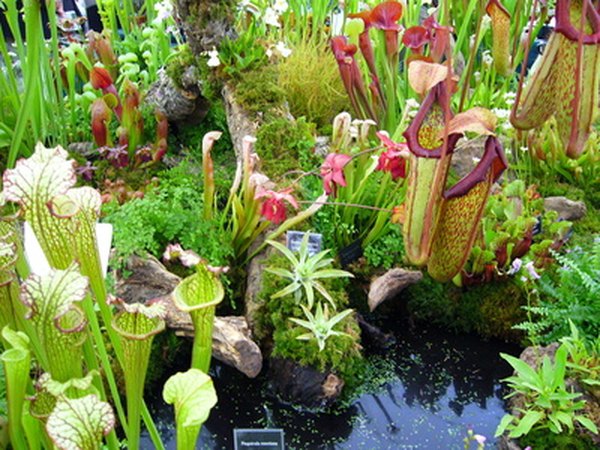
Flowering plants and insects often exist in mutually beneficial relationships. We are familiar with the idea that insects such as honey bees are essential to plants' reproductive processes, but there are other ways that plants can benefit from their association with insects. Plants may receive food, protection from predators, or get help with their growing conditions.
History
The relationship between flowering plants and insects goes back to around 130 million years ago, when fossil records indicate that the first blooming plants appeared. The first winged insects had emerged 200 million years prior. According to a 2002 article in "National Geographic Magazine" by Michael Klesius, scientists postulate that early flowering plants and insects began to evolve together in a process called co-evolution. Insects helped the plants to reproduce more efficiently while receiving benefits of food and shelter. The plants that were more likely to reproduce were the ones that were best able to attract insects to provide pollination services.
Some specific plants and insects have evolved together so closely that each is completely dependent upon the other. This extreme co-evolution is called mutualism. J. Stein Carter from the University of Cincinnati illustrates mutualism in his example of the yucca plant and the yucca moth. The yucca plant has evolved a flower that is shaped so that it can only be pollinated by the tiny yucca moth.
Plant Reproduction

Pollination is the mechanism by which flowering plants reproduce. Within their blooms, plants produce ovules and pollen, which both contain genetic material that must be combined in order to create seeds. The seeds have the potential to grow into mature plants. Bees, wasps, butterflies, moths, flies and even some beetles can carry pollen from one flower to another. For self-pollinating flowers, insects move pollen to the parts of the flower that need it. Some insects can carry pollen over long distances, which can help to spread genetic diversity in a plant population.
Protection

Some insects provide protection to the flowering plants on which they live and feed. An article from Marietta College describes the relationship between acacia ants and acacia trees. The ants get food and shelter from the tree; in return, they kill other insects that could eat the acacias and even deter some animal herbivores from eating the leaves, as well. In some environments the acacia ants will destroy other plants growing nearby in order to give their acacia more room to grow.
Farmers sometimes buy ladybugs to assist with crop management. While ladybugs serve as excellent pollinators, they also eat aphids. Aphids are very tiny insects that harm food crops by sucking the liquids out of the plants that can weaken or kill them.
Food

Some plants benefit from insects by eating them. These unusual flowering plants live in areas where nutrition is scarce. They have evolved to capture and digest insects. They may use color, scent and nectar to draw their prey to them in much the same way that other flowering plants draw pollinators. The difference is that insectivorous plants have mechanisms that will trap and then keep insects from escaping.
Importance

Flowering plants make up about 70 percent of the world's plant populations, with 235,000 species worldwide. Almost all of our nonmeat foods begin as flowering plants, and most of our meat sources are fed with the products of flowering plants. The benefits that insects provide to flowering plants directly and indirectly affect all life on the planet.
References
Resources
About the Author
Rose Guastella is a professional artist and teacher from Kitsap County, Wash. She has been writing educational materials for schools since before 1990. Guastella holds a Master of Arts in liberal studies from the State University of New York at Stony Brook. She has contributed several articles about education and plant biology to various websites.
Photo Credits
schmetterling image by Timo Kohlbacher from Fotolia.com
